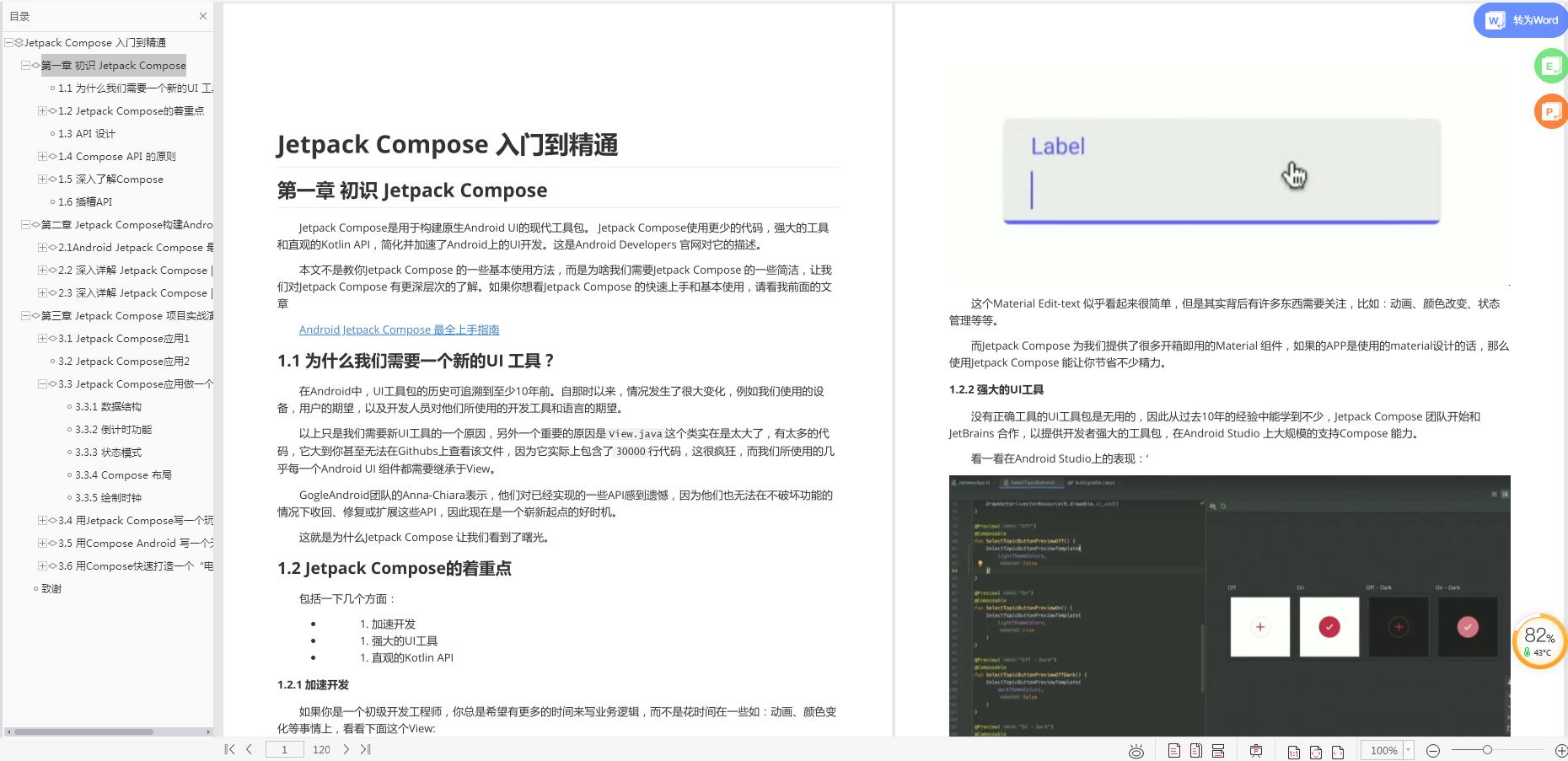Jetpack Compose 自定义布局以及固有特性测量
Posted Android Developer
tags:
篇首语:本文由小常识网(cha138.com)小编为大家整理,主要介绍了Jetpack Compose 自定义布局以及固有特性测量相关的知识,希望对你有一定的参考价值。
这篇文章我们会讲解下,Compose中如何去自定义布局,以及Intrinsic Measurement(官方翻译为固有特性测量)的理解跟使用。
一:自定义布局
自定义布局可以通过两种方式去处理,一种是使用布局修饰符Modifier.layout,一种是使用Layout去创建自定义布局。我们先来讲下Modifier.layout的方式
1.1 使用布局修饰符来实现自定义布局
我们自定义一个Modifier的扩展函数,Modifier.customCornerPosLayout。该方法的作用就是可以按我们传入的CornerPosition,去把view放置在左上角,左下角,右上角,右下角。代码如下:
enum class CornerPosition
TopLeft,
TopRight,
BottomLeft,
BottomRight
fun Modifier.customCornerPosLayout(pos:CornerPosition) = layout measurable, constraints ->
// Measure the composable
val placeable = measurable.measure(constraints)
layout(constraints.maxWidth, constraints.maxHeight)
// Where the composable gets placed
when(pos)
CornerPosition.TopLeft->
placeable.placeRelative(0, 0)
CornerPosition.TopRight->
placeable.placeRelative(constraints.maxWidth-placeable.width, 0)
CornerPosition.BottomLeft->
placeable.placeRelative(0, constraints.maxHeight-placeable.height)
CornerPosition.BottomRight->
placeable.placeRelative(constraints.maxWidth-placeable.width, constraints.maxHeight-placeable.height)
复制代码
- 首先我们声明一个枚举。叫CornerPosition,枚举有四种取值,TopLeft表示左上角,TopRight右上角,BottomLeft左下角,BottomRight又下角。
- 接着我们定义一个Modifier的扩展函数customCornerPosLayout,入参是pos:CornerPosition我们的枚举类
- customCornerPosLayout的实现是通过layout的lamda去实现。其实是调用Modifier.layout去实现自定义布局。有两个参数一个是measurable,一个是constraints父控件的约束
- 自定义布局第一步val placeable = measurable.measure(constraints) 是根据measurable跟constraints父控件的约束,通过方法measurable.measure(constraints)去生成一个placeable类。该类拥有子控件的宽width跟高height
- 自定义布局的第二部 需要调用layout(w,h)的方法去设置当前view能使用的宽高。我们这里是用layout(constraints.maxWidth, constraints.maxHeight) 传入的是constraints.maxWidth父控件提供能使用的最大宽,constraints.maxHeight父控件提供能使用的最大高
- 接着第三部就是在layout里通过 placeable.placeRelative 去放置该元素的位置。我们这里是根据传入的参数是左上角CornerPosition.TopLeft,还是左下角CornerPosition.BottomLeft,还是右上角CornerPosition.TopRight,还是右下角CornerPosition.BottomRight去放置该界面元素的位置。
- placeable.placeRelative(0, 0) 左上角是0,0
- placeable.placeRelative(constraints.maxWidth-placeable.width, 0) 右上角 x是需要拿最大宽度减去本身view的宽度,y是0
- placeable.placeRelative(0, constraints.maxHeight-placeable.height) 左下角x是0,y是需要拿最大的高度减去本身的高度
- placeable.placeRelative(constraints.maxWidth-placeable.width, constraints.maxHeight-placeable.height) x是需要拿最大宽度减去本身view的宽度,y需要拿最大的高度减去本身的高度
举例:自定义完成之后,我们举个放置在右下角的例子
@Preview
@Composable
fun customCornerPosLayoutTest()
Box(modifier = Modifier.size(100.dp)
.background(color = Color.Red))
Box(modifier = Modifier
.customCornerPosLayout(CornerPosition.BottomRight)
.size(10.dp)
.background(color = Color.Blue, shape = CircleShape))
复制代码
效果如下: 
1.2 Layout创建自定义布局
Modifier.layout修饰符仅更改调用的可组合项。如需测量和布置多个可组合项,请改用 Layout。在 View 系统中,创建自定义布局我们是会扩展 ViewGroup 并实现onMeasure和onLayout函数。在 Compose 中,我们只需使用 Layout 可组合项编写一个函数即可。
下面我们通过Layout去自定义一个有方向的Column布局。直接上代码
@Composable
fun CustomColumnView(
layoutDirection:LayoutDirection,
modifier: Modifier = Modifier,
content: @Composable() () -> Unit)
Layout(
modifier = modifier,
content = content
) measurables, constraints ->
var totalHeight = 0
var maxWidth = 0
val placeables = measurables.map
val placeable = it.measure(constraints)
totalHeight+=placeable.height
if(placeable.width>maxWidth)
maxWidth = placeable.width
placeable
layout(maxWidth,totalHeight)
if(layoutDirection == LayoutDirection.Ltr)
var y = 0
placeables.forEach
it.place(0,y)
y+=it.height
else
var y = totalHeight
placeables.forEach
y-=it.height
it.place(0,y)
复制代码
-
我们定义了一个CustomColumnView的可组合函数
-
定义了三个参数,layoutDirection去控制方向,modifier修饰符,内容可组合函数content。
-
内部的实现我们是通过Layout去自定义布局
-
测量每个子view的宽高 val placeable = it.measure(constraints) 自定义布局第一步需要通过父控件给的约束条件constraints跟measurable去执行measure测量。获得Placeable对象。该对象里可以获取到测量完成的每个子item的宽width跟高height。
-
接着我们根据测量好的所有的子view的宽高,可以去计算出我们自定义CustomColumnView所需要的宽高,高我们用totalHeight变量先存储,宽我们用maxWidth变量存储
-
totalHeight+=placeable.height 我们把每个子View的高累加起来就是CustomColumnView控件的高。
-
if(placeable.width>maxWidth)maxWidth = placeable.width 我们把子View最大的宽作为CustomColumnView的宽。
-
计算完成CustomColumnView的宽高之后,我们需要调用layout(maxWidth,totalHeight)方法去设置CustomColumnView的宽高
-
并且需要在layout方法里去调用placeable.place(x, y) 去放置子View的位置
layout(maxWidth,totalHeight) if(layoutDirection == LayoutDirection.Ltr) var y = 0 placeables.forEach it.place(0,y) y+=it.height else var y = totalHeight placeables.forEach y-=it.height it.place(0,y) 复制代码 -
比如上面的例子中我们是根据方向layoutDirection == LayoutDirection.Ltr 我们就从上到下放置子View。it.place(0,y) y初始值是0,并且y是一直累加上上一个子View的高度
-
否则我们就从下到上去放置子View,it.place(0,y) y初始值是totalHeight即CustomColumnView的高度也就是在最底部,并且y是一直去减去当前子View的高度。这样就能从底部往上放置了
封装完成自定义的CustomColumnView后,我们举例使用 从上往下排列的CustomColumnView
@Preview
@Composable
fun bottomToTopCustomColumnTest()
CustomColumnView(
layoutDirection = LayoutDirection.Ltr,
modifier = Modifier.background(color = Color.Red)
)
Text(text = "第一个Text第一个Text第一个Text第一个Text")
Text(text = "第二个Text")
Text(text = "第三个Text")
Text(text = "第四个Text")
Text(text = "第五个Text第五个Text")
复制代码
效果如下: 
从下往上排列的CustomColumnView
@Preview
@Composable
fun bottomToTopCustomColumnTest()
CustomColumnView(
layoutDirection = LayoutDirection.Rtl,
modifier = Modifier.background(color = Color.Red)
)
Text(text = "第一个Text第一个Text第一个Text第一个Text")
Text(text = "第二个Text")
Text(text = "第三个Text")
Text(text = "第四个Text")
Text(text = "第五个Text第五个Text")
复制代码

二:Intrinsic Measurement(固有特性测量)
以前在android的View系统中,存在多次测量。所以在View系统中我们为了优化性能,要求减少布局层次的嵌套。而在Compose中,子项只能测量一次,测量两次就会引发运行时异常,所以在Compose中各种嵌套子项是不会影响性能的。Compose中为啥能做到不需要测量多次呢,就是因为有了这个Intrinsic Measurement(固有特性测量)。
Intrinsic Measurement 是允许父项对子项测量之前,先让子项测量下自己的最大最小的尺寸。 使用官网的例子讲解:比如我们想要达到下面的效果 
我们的代码如下去写:
@Preview
@Composable
fun twoViewTest()
Row()
Text(
modifier = Modifier
.weight(1f)
.padding(start = 4.dp)
.wrapContentWidth(Alignment.Start),
text = "Hi"
)
Divider(color = Color.Black, modifier = Modifier
.fillMaxHeight()
.width(1.dp))
Text(
modifier = Modifier
.weight(1f)
.padding(end = 4.dp)
.wrapContentWidth(Alignment.End),
text = "there"
)
复制代码
我们以为row的高度会自动的是Text的高度。而出来的效果却是如下: 
之所以出现这种情况,是因为 Row 会逐个测量每个子项,并且 Text 的高度不能用于限制 Divider。为此,我们可以使用 height(IntrinsicSize.Min) 修饰符。我们使用IntrinsicSize.Min去告知使用的高度是子项本身的最小高度就可以了。代码如下修改:
@Preview
@Composable
fun twoViewTest()
Row(modifier = Modifier.height(IntrinsicSize.Min))
Text(
modifier = Modifier
.weight(1f)
.padding(start = 4.dp)
.wrapContentWidth(Alignment.Start),
text = "Hi"
)
Divider(color = Color.Black, modifier = Modifier
.fillMaxHeight()
.width(1.dp))
Text(
modifier = Modifier
.weight(1f)
.padding(end = 4.dp)
.wrapContentWidth(Alignment.End),
text = "there"
)
复制代码
这样就达到了我们所要的效果 
这就是固有特性的使用,他们可以提供IntrinsicSize.Min跟IntrinsicSize.Max。子项本身自己的最大最小的尺寸
Jetpack compose在开源项目:https://github.com/Android-Alvin/Android-LearningNotes 中已收录,里面还包含不同方向的自学编程路线、面试题集合/面经、及系列技术文章等,资源持续更新中…
以上是关于Jetpack Compose 自定义布局以及固有特性测量的主要内容,如果未能解决你的问题,请参考以下文章
